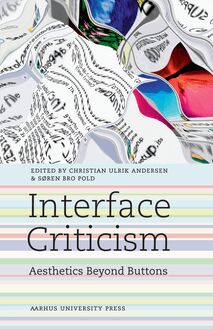-
 Univers
Univers
-
 Ebooks
Ebooks
-
 Livres audio
Livres audio
-
 Presse
Presse
-
 Podcasts
Podcasts
-
 BD
BD
-
 Documents
Documents
-
- Cours
- Révisions
- Ressources pédagogiques
- Sciences de l’éducation
- Manuels scolaires
- Langues
- Travaux de classe
- Annales de BEP
- Etudes supérieures
- Maternelle et primaire
- Fiches de lecture
- Orientation scolaire
- Méthodologie
- Corrigés de devoir
- Annales d’examens et concours
- Annales du bac
- Annales du brevet
- Rapports de stage
La lecture à portée de main
296 pages
English
Découvre YouScribe en t'inscrivant gratuitement
Je m'inscrisInterface Criticism , livre ebook
Découvre YouScribe en t'inscrivant gratuitement
Je m'inscris
Obtenez un accès à la bibliothèque pour le consulter en ligne
En savoir plus
En savoir plus
296 pages
English
Obtenez un accès à la bibliothèque pour le consulter en ligne
En savoir plus
En savoir plus

Description
From the screen of our laptops, and from the ubiquitous portable devices, smart phones, and media players, to the embedded computation in clothes, architecture and big urban screens, interfaces are everywhere. They are simultaneously demanding our attention and computing quietly in the background, turning action into inter-action, and mediating our experience of and relations to the social and environmental. But how can aesthetics respond to this, and how do interfaces set the scene for artistic practices? Interface Criticism is not another design manual but a critical investigation for readers interested in the aesthetic, cultural and political dimensions of interfaces. With contributions from leading researchers within the field, the book covers a wide range of aesthetic expressions - including urban screens, wearable interfaces, performances, games, net-art, software art, and sound art, and discusses how new cultures evolve around, for example, open souce or live coding. The volume critically investigates the aesthetics of interfaces in ways that transcend the iconic surface of the graphical user interface and goes beyond the buttons. Ultimately the book develops interface aesthetics as an appropriate paradigm for a critical discussion of the computer.
Sujets
Informations
| Publié par | Aarhus University Press |
| Date de parution | 12 janvier 2011 |
| Nombre de lectures | 0 |
| EAN13 | 9788771243376 |
| Langue | English |
| Poids de l'ouvrage | 35 Mo |
Informations légales : prix de location à la page 0,1550€. Cette information est donnée uniquement à titre indicatif conformément à la législation en vigueur.
Extrait
Andersen
9I S B N 788779 345041 978-87-793-4504-1
edited by christian ulrik andersen & søren bro pold Interface Criticism Aesthetics Beyond Buttons
aarhus university press
Interface Criticism
edited by christian ulrik andersen & søren bro pold
Interface Criticism Aesthetics Beyond Buttons
aarhus university press
Interface Criticism Acta Jutlandica. Humanities Series 2011/1 © The authors and Aarhus University Press 2011 Cover design: CarlH.K. Zakrisson, Polytype Cover illustration: Alexei Shulgin Design: CarlH.K. Zakrisson, Polytype
issn00651354 (Acta Jutlandica) issn09010556 (Humanities Series 1) isbn9788771242393
Aarhus University Press Aarhus Langelandsgade 177 8200 Aarhus N
Copenhagen Tuborgvej 164 2400 Copenhagen NV www.unipress.dk Fax 89 42 53 80
International distributors: Gazelle Book Services Ltd. White Cross Mills Hightown, Lancaster, LA1 4XS United Kingdom www.gazellebookservices.co.uk
The David Brown Book Company Box 511 Oakville, CT 06779 USA www.oxbowbooks.com
Published with the financial support of The Aarhus University Research Foundation Novo Nordisk Fonden
Research supported by The Danish Council for Independent Research, Humanities Center for Digital Urban Living (The Danish Council for Strategic Research, KINO, grant number 2128070011) Digital Aesthetics Research Center
introduction: Interface Criticism
7
back: Displays and History erkki huhtamoMonumental Attractions: Toward An Archaeology of Public Media Interfaces 21 bodil marie stavning thomsenThe Haptic Interface: On Signal Transmissions and Events 43 through: Sensation and Perception lone koefoed hansenThe Interface at the Skin 63 søren bro poldInterface Perception: The Cybernetic Mentality and Its Critics: Ubermorgen.com 91 behind: Representation and Computation florian cramerWhat Is Interface Aesthetics, or What Could It Be (Not)? 117 dragana antic and matthew fullerThe Computation of Space 130 down: Software and Code geoff coxof Software Meansend 145 morten breinbjergPoesis of HumanComputer Interaction: Music, Materiality and Live Coding 162 christian ulrik andersen Writerly Gaming: Political Gaming
178
out: Culture and Politics henrik kaare nielsenThe Net Interface and the Public Sphere 203 jacob lillemoseThere Really Only One Word For It? Is Software Vocabularies in the Expanded Field of Interface Aesthetics inke arns Transparent World: Minoritarian Tactics in the Age of Transparency 253
christophe brunoHallucination and Capitalism 2.0: Collective Scalefree Elections in France 279
About the Authors
293
223
19
61
115
143
201
277
Interface Criticism * Aesthetics Beyond Buttons
by christian ulrik andersen & søren bro pold
The human computer interface has been a growing part of our cul ture for decades. First came the early experiments with computer graphics and games in the 1960s, then the commercial introduction of graphical user interfaces in the mid1980s, and today computer interfaces take a myriad forms and are constantly met both at work and in our private lives. Wherever we go, we find physical interfaces such as the mouse, keyboards, controllers, touch screens, micro phones and cameras; we see visual interfaces such as desktop meta phors and computer game worlds; we hear audible interfaces such as sounds signalling the state of a machine, the startup of an oper ating system, an incoming text message, or more sophisticated audio interfaces as in audio based games and sound art. The range of inter faces is expanding to meet the needs of different technologies, uses, cultures and contexts: mobile, networked, ubiquitous or embedded in the environment and architecture. Some interfaces may evenbe designed to be invisible and imperceptible such as those used in surveillance and tracking technologies. No matter how or where, the interface is a dominant cultural form providing a way to mediatebetween humans and machines and between culture and data,affecting the way we perceive cultural activities and perform them in public and private. Interfaces are designed with specific purposes, some very narrow and technically determined as technical protocols, others moreapplication and end user oriented such as interfaces for reading, see ing, listening, communication and experience. Until recently, ithas been common practice to discuss interfaces primarily from an
* Thanks to Claire Neesham for language correction.
8
Interface Criticism –Aesthetics Beyond Buttons
engineering perspective, as something that should be optimised to offer seamless functionality. This approach has led to the ‘whatyou seeiswhatyouget’text editors and the emphasis on userfriendly and transparent design. The main idea is that the computer should blend smoothly into our homes and environments as something we do not have to deal with consciously. Simultaneous with the development of the interface, and often in a critical dialogue with this, a digital aesthetics has developed. Even as early as the 1960s, different digital art forms and early computer games were starting to explore the emerging formal languages and new aesthetics of the computer in which it was designed to be expe rienced; therefore transparency and seamless functionality werenot the goal. For many years this meant an apparent antagonism be tween digital art and interface design. As interface design becomes more diverse, however, it affects cultural practices in new ways, and the antagonism between art and design is thus beginning to dissolve
with current developments in design and technology. Business com
munication has discovered experience oriented design, and comput ers, smart phones and gadgets are prime fashion objects and cultur ally coded. Furthermore, in the reign of Web 2.0, the economy ofinterfaces is changing from a traditional production mode based on employed software developers to being more network oriented and user driven (with the side effect of providing free labour) while still restricting and containing their work. Simultaneously, programmers are becoming culturally and politically aware and engage in the free software movement. Even certain forms of digital art are startingto enter the mainstream both commercially and institutionally. This development calls for a new discussion of the role of digital art and aesthetics within an interface culture where art is increasingly inter mingling – though not coinciding – with design. This book aims to offer a much needed perspective on the roleof artistic practices and aesthetic theory within interface culture.As editors of the book, we see interface criticism as an appropriate paradigm for a critical discussion of the computer and how it relates to art and culture today. In the contributions to the book we finda discussion of both developments: how interfaces are related to cul ture, and how art has developed around interfaces, often under
c h r i s t i a n u l r i k a n d e r s e n & s ø r e n b r o p o l d
mining common conceptions of the interface. But, before we begin our discussion, we need to defineinterfaceand describe what we mean byinterface criticismasaesthetics beyond buttons.
Our conception of theinterfaceis not restricted to the wellknown graphical user interface between humans and computers, e.g. the WIMP (Windows, Icons, Menus, Pointers) interfaces that have be come popular and standardised on personal computers the last twentyfive years. As described by Florian Cramer in this volume,the term interface indicates many different contact points and ex changes between different programs and data layers in a computer, between different machines (e.g. in a network), between humans and machines (such as graphical user interfaces), and as a mediator between humans (e.g. in net culture, interface culture and thepublic sphere). Some interfaces seem more or less mechanical – such as the USB interface that most of us know as a plug, but which is in fact an interface that specifies how communication between devices is established – while others are more clearly directed towards human understanding and cultural traditions such as interfaces for compu ter games or digital art. All interfaces, however, are designs that com bine – and translate – signs and signals. As such, the interface is at the core of the computer. It is not possible to ‘unveil’ the computer through a deconstruction of the interface. The code behind theinterface is just another interface in the layered ‘mise en abîme’architecture of the computer. The functioning of the interface, itsdesigned juxtaposing of human signs and machine signals, is there fore essential to the functioning of the computer. The question ofinterface aestheticsis intrinsically linked to our perception of the interface. If it is not possible to fully ‘unveil’ the ‘mise en abîme’ of the interface we can, however, elucidate howinterfaces can embed choices, conduct, languages, and ultimately values, worldviews and aesthetics into technical infrastructures. The word aesthetics derives from the Greek ‘aisthesis’ that means sense perception, and today we perceive our environment through inter faces. Aesthetic theory consequently needs to develop a criticalvocabulary towards computers and interfaces, aninterface criticism, and this book aims to be one such contribution. An aesthetic aspect
9
-
 Univers
Univers
-
 Ebooks
Ebooks
-
 Livres audio
Livres audio
-
 Presse
Presse
-
 Podcasts
Podcasts
-
 BD
BD
-
 Documents
Documents
-
Jeunesse
-
Littérature
-
Ressources professionnelles
-
Santé et bien-être
-
Savoirs
-
Education
-
Loisirs et hobbies
-
Art, musique et cinéma
-
Actualité et débat de société
-
Jeunesse
-
Littérature
-
Ressources professionnelles
-
Santé et bien-être
-
Savoirs
-
Education
-
Loisirs et hobbies
-
Art, musique et cinéma
-
Actualité et débat de société
-
Actualités
-
Lifestyle
-
Presse jeunesse
-
Presse professionnelle
-
Pratique
-
Presse sportive
-
Presse internationale
-
Culture & Médias
-
Action et Aventures
-
Science-fiction et Fantasy
-
Société
-
Jeunesse
-
Littérature
-
Ressources professionnelles
-
Santé et bien-être
-
Savoirs
-
Education
-
Loisirs et hobbies
-
Art, musique et cinéma
-
Actualité et débat de société
- Cours
- Révisions
- Ressources pédagogiques
- Sciences de l’éducation
- Manuels scolaires
- Langues
- Travaux de classe
- Annales de BEP
- Etudes supérieures
- Maternelle et primaire
- Fiches de lecture
- Orientation scolaire
- Méthodologie
- Corrigés de devoir
- Annales d’examens et concours
- Annales du bac
- Annales du brevet
- Rapports de stage
Signaler un problème
YouScribe
Le catalogue
Le service
© 2010-2024 YouScribe









